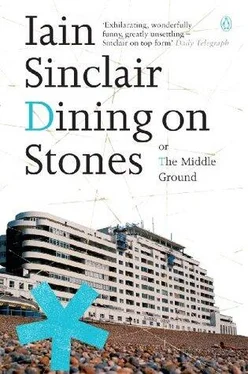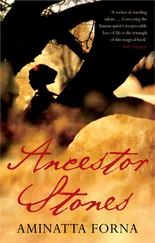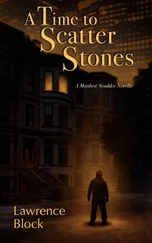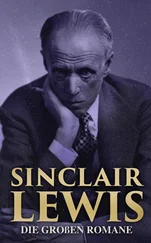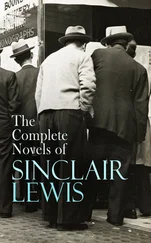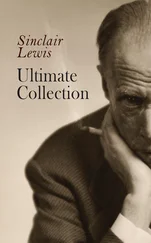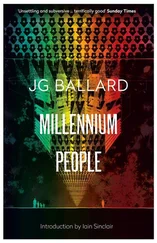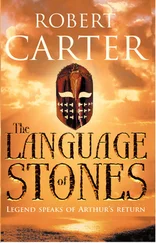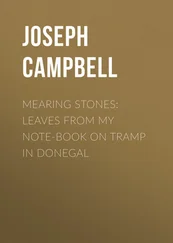Norton remembered: the future tabloid story, how it turned out. Drug-crazed psycho, head filled with John Woo and Mishima, kidnaps former lover, an artist (journalists relish the implication). He drives out to the M25, parks up. Strips to the waist, produces a Samurai sword. Then blows it. Seppuku aborted: in favour of a merciless killing. Murder. The decapitation of the girl, the student.
His stained shirt was found in bushes by the side of the carriageway, as was a Japanese sword dating from the Meiji-restoration period. The sword was estimated later to be worth over eighteen thousand pounds. The police identified the antique as part of a collection stolen in a hold-up on a famous antique house delivery van earlier that year on the south coast. During the post mortem a number of incisions were found in the stomach area of the killer’s body. His blood contained a massive amount of cocaine and amphetamine.
The killer, Reo Sleeman, hacked off the woman’s head and ran into the road, brandishing it like a lantern.
He stepped in front of a Dutch HGV carrying 25 tonnes of plasterboard. The time was 4.15 AM.
4.12 on the bedside clock, red figures glowing.
‘Do — something .’
Track shaking Norton. Jimmy flexing his cuffs.
Stars are our eyes: Beckmann.
‘Take long walks,’ the painter said, ‘and take them often, and try your utmost to avoid the stultifying motor car which robs you of your vision, just as the movies do, or the numerous motley newspapers.’
Falling Man (1950).
Norton, naked, at the window. Two figures, clothed, behind him. The frame seen from the car park.
If you revolve Beckmann’s painting, stand it on its head, it works. A swimmer plunging, arms outstretched, into a flower-strewn river. Feet like paddles. Out of the clouds: boats of angels, fires in windows. Down from heaven into the lifeless earth of a motorway hotel.
Beckmann understood, better than anyone, the mystery of the middle ground: he abolished it . The falling man, painted in New York, in the last year of his life, has no middle ground. The naked figure, close to the window, losing his green robe, bath towel, dominates the foreground. Black hair like the painter’s favourite skullcap. The flying man — man who has forgotten how to fly, lost his wings — reaches out to touch, with thick, vegetal fingers, ‘unknown space’. His soul transmigrates into the absence of middle ground (a collar like the orbital motorway).
4.13 a.m.: Track propelling Norton, wheeling him, stiff as a corpse, towards the liquefying barrier of the window.
‘Time,’ Beckmann wrote, ‘is the invention of mankind; space or volume, the palace of the gods.’
Mitchum and Jane Russell: the posthumous embrace of mastodons. Macao. Lovers entombed in a block of Jell-O.
Wassily Kandinsky: ‘Space is death.’
Cameras pick up a running figure, a naked man; out of the ibis car park, over the fence, across wasteground. Up the long ramp, sliproad — logged on surveillance monitors. Through six lines of stationary traffic.
The night of West Thurrock is not The Night (1918–19) of Max Beckmann; no bondage (except on digital channel, by supplementary payment); no Lenin, no pipe (smoking forbidden). No candles of lard in the electrified motel.
A.M. Norton has found his muse: murder. She is upside down on his bed, red slippers, scarf around neck, voluptuously nude. Her hand rests on her own gently heaving belly. Hannah listens to his story: seaside, failing eyes, failure of imagination. Standing member, huge, aubergine-purple.
Twin windows — sex rituals, falling man: side-panels of an unfinished triptych: The M25 Slaughter.
A naked runner, exploiting the corridor of the middle ground, between actuality and fiction, arrives unmolested at the American car. He opens the passenger door and taking the woman’s hand leads her through the lines of stalled traffic to the ramp (an Expressionist motif).
To Track. Who has run down the back stairs, out of the hotel, across the waste ground. To embrace her lost friend.
So it is Norton that Reo Sleeman strikes (it always was). A clean cut. In the green glow of the dashboard. Norton: Green Knight. Spouting blood. Like a petrol pump gushing over the forecourt.
The radio in Room 234 acts as an alarm. A wake-up call for the walk to Canvey Island. Capital Radio’s Flying Eye announces a twenty-eight-mile tailback, the worst in the history of London’s orbital motorway.
Severed head in hand, grasped by a thin crop of neck hair, Reo Sleeman ran into the road. 4.14 a.m. It hasn’t happened yet. Night traffic in spate. Clubbers from Basildon. Reps from Chafford Hundred. Lakeside deliveries. A Dutch HGV loaded with plasterboard, watching out for a difficult turn.
The impact barely felt. Driver in shock. Sweet tea. Sleeman tossed aside, crumpled. The head rolling, rolling, rolling. Eyes like fiery coals. Into scrubgrass. Down the embankment. Into the dark. The whole performance, captured on surveillance monitors, became a legend among snuff movies: the Citizen Kane of necrophilia, death of a nation.
Sleeman’s funeral at Chingford Mount was well attended by men with shaven heads, sovereign rings, dark glasses and long black coats. Crocodile limos, nose to tail, stretched back as far as the North Circular. Florists were denuded. Notable among several highly inventive floral tributes were wreaths shaped like boxing rings, Mount Fuji, like jukeboxes. Respects were offered, upper-case carnations, by the serial mourners of gangland: Freddie Foreman, Tony Lambrianou, Dave Courtney (in charge of security), Kenny Noye, Bernard O’Mahoney (author of Essex Boys ), Howard Marks and half the cast of EastEnders .
It was decided, after consultation with the family, a visit to Alby Sleeman in Maidstone (two counts of life imprisonment, armed robbery, assault on security guard), that the song for the crematorium, to play Reo out, would be Wheels (Keep A-Rollin) from the album That Man Robert Mitchum … Sings (Monument Records).
Forensic examination of Reo’s Samurai sword led to the capture of the perpetrators of a south coast raid on a van of antiques, ‘mainly from China and Japan’, conservatively valued at half a million pounds. A subsequent search of Alby’s London Fields lock-up recovered three kilos of cocaine, 7,000 ecstasy tablets and numerous bundles of very damp cannabis resin.
Of Norton, his head and his torso, there was no trace. The man had vanished. Some commentators doubted that he had ever existed. There was no entry in the register at the ibis. Katherine Cloud Riise (32) and Olivia Fairlight-Jones (30), despite substantial offers from the tabloids, were not giving interviews.
All too late. Norton was destined not to discover the thing that troubled him most — as he ran, naked, up the ramp: where Track got her name.
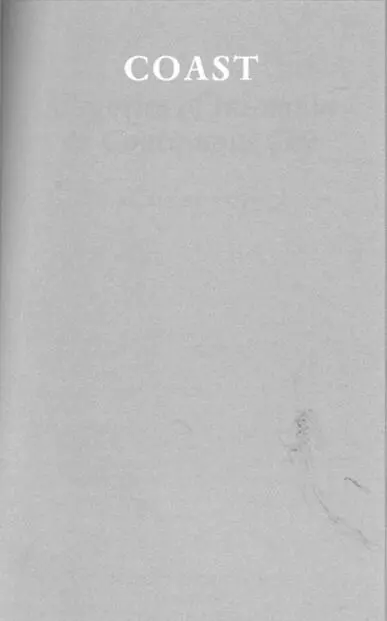
A. M. Norton ALLEGORIES OF INSOMNIA & CONTINUOUS SKY
naked in the sea air and amongst the dead
— Catherine Millet
So much experience, and so little of it experienced, lived through, exploited. So many broken phrases. Failing windows, failing eyes. The moon is a suicide’s eye. The missing eye of Rooster Cogburn .
The way we repeat ourselves, dust down the same lifeless metaphors: discovering old notebooks with abandoned versions of new stories. Too late to be picky.
There is a certain pathos, a degree of comedy, to be wrung out of physical decay, stalled ambition, inappropriate lust: the skeleton propped on the balcony like a wind chime. Hollywood contrives an upbeat ending, dignity for the carcinogenic gunfighter who has to be winched onto his horse. The south coast is crueller, more practical. Home helps in the lift, the compost of memory packed away in hutches for the elderly, Edwardian and Victorian mansions on high ridges — the sound of the sea fading away by barely noticed increments.
Читать дальше
